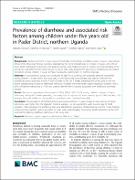| dc.contributor.author | Omona, Stephen | |
| dc.contributor.author | Malinga, Geoffrey M. | |
| dc.contributor.author | Opoke, Robert | |
| dc.contributor.author | Openy, Geoffrey | |
| dc.contributor.author | Opiro, Robert | |
| dc.date.accessioned | 2020-01-20T08:37:06Z | |
| dc.date.available | 2020-01-20T08:37:06Z | |
| dc.date.issued | 2020-01-13 | |
| dc.identifier.citation | Omona, S., Malinga, G. M., Opoke, R., Openy, G., & Opiro, R. (2020). Prevalence of diarrhoea and associated risk factors among children under five years old in Pader District , northern Uganda. BMC Infectious Diseases, 20(37), 1–9. https://doi.org/https://doi.org/10.1186/s12879-020-4770-0 | en_US |
| dc.identifier.issn | 1471-2334 | |
| dc.identifier.uri | http://dir.muni.ac.ug/xmlui/handle/20.500.12260/324 | |
| dc.description.abstract | Background: Diarrhoea remains a major cause of morbidity and mortality in children under 5 years in sub-Saharan Africa. Of the three East African countries, Uganda has the worst mortality rate in children < 5 years, with 22% of these deaths attributed to diarrhoea. For proper planning and implementation of control, an understanding of the prevalence and determinants of the disease is crucial. This study assessed the prevalence of diarrhoea and related risk factors among children < 5 years in Pajule Subcounty, Pader District in northern Uganda. Methods: A cross-sectional survey was conducted in April 2018, covering 244 randomly selected households having children < 5 years old in the study area. A semi-structured questionnaire was used to interview the households about diarrhoeal history in their children in the last 2 weeks preceding the survey, and on the risk factors predisposing children to diarrhoeal infections. Bivariate and multivariate logistic regression analyses with a 95% confidence interval and p < 0.05 was used to identify the risk factors associated with childhood diarrhoeal disease. Results: We found a prevalence of diarrhoea of 29.1% [95% CI (23.7–35.0)] among children < 5 years in Pajule Subcounty during the 2 weeks preceding the survey. Use of unprotected water sources, age of child caretaker, child weaning time and family size had significant associations with diarrhoeal morbidity. Conclusion: The prevalence of childhood diarrhoea among children < 5 years of age in rural settings of Pajule Subcounty was higher than the Ugandan national average. Use of unprotected water sources, age of child caretaker, child weaning time and family size were identified as predictors of diarrhoeal occurrence. These findings underscore the need for improving access to clean water and providing community health education as the best methods for fighting childhood diarrhoea in the study area. | en_US |
| dc.language.iso | en | en_US |
| dc.publisher | BMC Infectious Diseases | en_US |
| dc.relation.ispartofseries | Vol.20;No.37 | |
| dc.subject | Bivariate | en_US |
| dc.subject | Logistic regression | en_US |
| dc.subject | Multivariate | en_US |
| dc.subject | Risk factor | en_US |
| dc.subject | Pajule | en_US |
| dc.subject | Uganda | en_US |
| dc.title | Prevalence of diarrhoea and associated risk factors among children under five years old in Pader District, northern Uganda | en_US |
| dc.type | Article | en_US |

